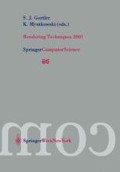Abstract
The performance of hardware-based interactive rendering systems is often constrained by polygon fill rates and texture map capacity, rather than polygon count alone. We present a new software texture caching algorithm that optimizes the use of texture memory in current graphics hardware by dynamically allocating more memory to the textures that have the greatest visual importance in the scene. The algorithm employs a resource allocation scheme that decides which resolution to use for each texture in board memory. The allocation scheme estimates the visual importance of textures using a perceptually-based metric that takes into account view point and vertex illumination as well as texture contrast and frequency content. This approach provides high frame rates while maximizing image quality.
Access this chapter
Tax calculation will be finalised at checkout
Purchases are for personal use only
Preview
Unable to display preview. Download preview PDF.
Bibliography
A. C. Beers, M. Agrawala and N. Chaddha. Rendering from Compressed Textures. SIGGRAPH’ 96 Conference Proceedings.
J. Blow. Implementing a Texture Caching System. Game Developer. April 1998.
M. R. Bolin and G. Meyer. A Perceptually Based Adaptive Sampling Algorithm. SIGGRAPH’ 98 Conference Proceedings.
S. E. Chen. Quicktime VR — An image-Based Approach to Virtual Environment Navigation. ACM SIGGRAPH’ 95 Conference Proceedings.
D. Cline and P. K. Egbert. Interactive Display of Very Large Textures. IEEE Visualization’ 98 Conference Proceedings.
D. Cohen-Or, E. Rich, U. Lerner and V. Shenkar. A Real-Time Photo-Realistic Visual Flythrough. IEEE transaction on Visualization and Computer Graphics, 1996.
S. Daly. The Visual Difference Predictor: An Algorithm for the Assessment of Visual Fidelity. Digital Image and Human Vision, MIT Press, 1993.
T. A. Funkhouser and C. H. Sequin. Adaptive Display Algorithms for Interactive Frame Rates During Visualization of Complex Virtual Environments. SIGGRAPH’ 93 Conference Proceedings.
I. Homan, M. Eldridge. K. Proudfoot, Prefetching in a Texture Cache Architecture. Proc. 1998 Eurographics/Siggraph workshop on graphics hardware
E. Horvitz and J. Lengyel. Perception, Attention, and Resources: A Decision-Theoretic Approach to Graphics Rendering. Proceedings of the Thirteenth Conference on Uncertainty in Artificial Intelligence. 1997.
P. Lindstrom, D, Koller, L. F. Hodges, W. Ribarsky, N. Faust and G. Turner. Level-of-Detail Managements for Real-Time Rendering of Photo-Textured Terrain. GIT-GVU Technical Report, 1995.
T. Möller and E.Haines. Real-Time Rendering. AK Peters, 1999.
K. Myszkowski. The Visible Differences Predictor: Applications to Global Illumination Problems. Eurographics Rendering Workshop’ 98 Proceedings, 1998.
K. Myszkowski, P. Rokita and T. Tawara. sPerceptually-informed accelerated rendering of high quality walkthrough sequences. Eurographics Rendering Workshop’ 99 Proceedings, 1999.
S. M. Oborn. UTAH: The Movie. Master’s Thesis, Utah State University, 1994.
M. Ramasubramanian, S. N. Pattanaik and D. Greenberg. A Perceptually Based Physical Error Metricfor Realistic Image Synthesis. ACM SIGGRAPH’ 99 Conference Proceedings.
Sahn. Approximate algorithms for the 0/1 knapsack problem. ACM Publication.
S3TC DirectX 6.0 Standard Texture Compression. S3 Inc., 1998.
J. Torborg and J. T. Kajiya. Talisman: Commodity Realtime 3D Graphics for the PC. SIGGRAPH’ 96 Conference Proceedings.
H. Yee, S. N. Pattanaik and D. P. Greenberg. Spatio-Temporal Sensitivity and Visual Attention in Dynamic Environments, accepted for publication in ACM Transactions on Computer Graphics (2001).
Author information
Authors and Affiliations
Editor information
Editors and Affiliations
Rights and permissions
Copyright information
© 2001 Springer-Verlag Wien
About this paper
Cite this paper
Dumont, R., Pellacini, F., Ferwerda, J.A. (2001). A Perceptually-Based Texture Caching Algorithm for Hardware-Based Rendering. In: Gortler, S.J., Myszkowski, K. (eds) Rendering Techniques 2001. EGSR 2001. Eurographics. Springer, Vienna. https://doi.org/10.1007/978-3-7091-6242-2_23
Download citation
DOI: https://doi.org/10.1007/978-3-7091-6242-2_23
Published:
Publisher Name: Springer, Vienna
Print ISBN: 978-3-211-83709-2
Online ISBN: 978-3-7091-6242-2
eBook Packages: Springer Book Archive

